A Fuzzy Model for Reasoning and Predicting Student’s Academic Performance
Abstract
1. Introduction
| Area | Methods or Techniques and the Study’s Reference |
|---|---|
| Prediction | Neuro-fuzzy [11,18,19,26,31,33] |
| Fuzzy decision tree [14] | |
| Genetic fuzzy [13,16] | |
| Fuzzy logical model [16,30] | |
| Fuzzy expert system [16] | |
| Fuzzy clustering + regression (integrated) [23] | |
| Fuzzy learning (fuzzy based on ML concepts) [24] | |
| Mamdani fuzzy [32] | |
| Classification | Neuro-fuzzy [12,18] |
| Qualitative link analysis [28] | |
| Decision-making | Fuzzy expert system [15,17] |
| Pythagorean fuzzy [21] | |
| Bayesian networks and fuzzy logic [22] | |
| Fuzzy VIKOR [25] | |
| Analysis and Evaluation | Forgotten (fuzzy) [13] |
| Fuzzy expert system [15,17] | |
| Data-driven fuzzy rule [20] | |
| Bayesian networks and fuzzy logic [22] | |
| Mamdani fuzzy [27] | |
| Qualitative link analysis [28] | |
| Genetic fuzzy [29] | |
| Fuzzy preference [34] | |
| Nested Probabilistic Linguistic Term Sets [35,36,37] |
2. The Model (FPM)
2.1. Determine the Propositional Rule
- 1.
- if A is true then B will be true
- 2.
- if A is not true then B may be true or not true, i.e., the “if A then B” rule accepts all cases of B (True or False).
2.2. Building the Fuzzy Sets (FS)
- i.
- The largest value i Gi isi G2 i = 130.3
- ii.
- The fuzzy set will be generated by dividing each element by 130.3 (G2) as follows:
- Fuzzy set = {{69/130.3, 130.3/130.3, 46.5/130.3, 17.7/130.3, 16.1/130.3, 8.1/130.3}
- Fuzzy set = {0.53, 1.00, 0.36, 0.14, 0.12, 0.06}
2.3. Constructing the Product Rule (Fuzzy Set Transformer Matrix (FTM))
- 1.
- Determine the component of the rule (A, B, and the relation between them). This rule is determined according to the problem or the system (for example, If the student attends the class to some degree x, then he will be marked in the course to some degree y)
- 2.
- Determine the fuzzy set that represents A in our production rule (for example, the attendance rate).
- 3.
- Determine the fuzzy set that represents B in our production rule (for example, the final mark).
- 4.
- Finally, the fuzzy set transformer (the production rule) will be obtained by applying the rule in Equation (4). None that the all the elements of Y are true, i.e., equal to 1 (Figure 2).
2.4. Make Use of the Production Rule (Implementing the FPM)
3. The Experiment
- 1.
- Most of Saudi universities, including our case of study, have a regulation to eliminate students according to absenteeism. The regulation in our case study is to deprive any student from completing the course if he is absent more than or equal to 25% of the time, which means that only the students with attendance rate greater than 75% are allowed to complete the course. Accordingly, it will be more difficult to examine the effect of absenteeism on students’ performance especially since most of the data have a low rate of absenteeism.
- 2.
- Another issue that makes the effect of absenteeism unclear is the availability of alternative online lectures or multimedia resources.
3.1. The Data Sets
3.1.1. The Fuzziness of the Student Performance Data (the Uncertainty)
- 1.
- The relation is uncertain, as there is no standard output for specific input where different students can obtain varieties of exam results even if they have the same attendance rate, and the opposite is also correct.
- 2.
- It is difficult to represent the sets in this rule using the normal set because we need to represent the degree of elements’ belongingness (membership degree), not only the elements’ belongingness (membership).
- Let A be the fuzzy set of degrees of the students’ attendance
- Let B be the fuzzy set of students’ results in the final exam
3.2. Building the Fuzzy Sets
- 1.
- Building the attendance fuzzy set (A):
- 2.
- Building the final exam fuzzy set (B):
- -
- As shown in Table 2, the largest value of the final exam is G20 = 39
- -
- Then, the exam fuzzy set B = {15/39, 26/39, 11/39, 17/39, 26/39, 21/39, 36/39, 28/39, 28/39, 26/39, 29/39, 37/39, 35/39, 20/39, 29/39, 39/39, 21/39, 32/39, 36/39, 39/39},
- 3.
- Y = {1,1,1,1,1,1,1,1,1,1,1,1,1,1,1,1,1,1,1,1}.
3.3. The Fuzzy Set Transformer (the Production Rule)
3.4. Testing the Model (FPM)
- 1.
- Attendance rate Atest = {0.76, 0.8, 0.82, 0.84, 0.84, 0.84, 0.87, 0.91, 0.91, 0.91, 0.91, 0.91, 0.91, 0.91, 0.93, 0.93, 0.93, 0.93, 0.96}
- 2.
- Then, by dividing each element by the 0.96 (the largest value G20), the fuzzy set of the attendance rate will be {0.79, 0.79, 0.83, 0.85, 0.88, 0.88, 0.88, 0.91, 0.95, 0.95, 0.95, 0.95, 0.95, 0.95, 0.97, 0.97, 0.97, 0.97, 0.97, 1}
- 3.
- Final exam result = {12, 10, 15, 30, 20, 14, 32, 19, 11, 13, 14, 13, 22, 25, 19, 16, 19, 26, 16, 13}
- 4.
- Then, by dividing each element by 32 (the largest value G7), the fuzzy set of the final exam will be {0.38, 0.31, 0.47, 0.94, 0.63, 0.44, 1, 0.59, 0.34, 0.41,0.44, 0.41, 0.69, 0.78, 0.59, 0.50, 0.59, 0.81, 0.50, 0.41}
4. Result and Discussions
4.1. Compare FPM with an Equivalent Model
- 1.
- First, the final exam data are transferred to rate (100%) to fit the attendance rate.
- 2.
- Second, building the linear regression model using formula in Equations (5) and (6). Table 4 presents this linear regression model:
- 3.
- Third, the regression model is tested using the same test data as shown in Table 5
- 4.
- Finally, Table 5 shows that the linear regression model predicted the final exam with 0.076 MSR, which is greater than our suggested FPM model (0.062242). This indicates that our suggested FPM model gives better results than the learner regression model. In addition, the prediction of the single values in our suggested FPM model showed better results than linear regression (Figure 8 and Figure 9).
4.2. Applying FPM on Other Students’ Academic Performance Dataset
- 1.
- The data set is the same data set that we used in our experiment, but here, we will use the lab exam instead of absence rate as shown in Table 6.
- 2.
- The correlation between the lab exam data and final exam data in the training data set is 0.942231 and on the test data set is 0.979643.
- 3.
- Because the data represents the relation between the lab exam and the final exam, the logic rule will be the following:
- if the student obtain marks in the lab exam to some degree x, then he will obtain marks in the final exam to some degree y.
4.3. Model Evalution
5. Conclusions
- 1.
- In the first aspect, this paper provided an investigative study that mostly covers the most recent research works on providing approaches, models, application, and/or evaluating studies for one or more of students’ academic performance issues. The investigative study reviewed 32 studies and concluded that these works provided 15 prediction models or approaches, 9 evaluation or analyses studies or models, 4 decision-making systems, and 3 classification models or approaches. Most of the fuzzy methods and techniques have been implemented over the investigated research works, with neuro fuzzy representing the most used method, where it has been used in nine works.
- 2.
- In the second aspect, this paper proposed a novel fuzzy model for dealing with students’ academic performance behaviors. The proposed model integrated the concept of fuzzy sets with the concept of propositional logic. Although the proposed model uses propositional logic concepts, it differs from the fuzzy logic approach that has been used in pervious works such as [15,16,17,22,30,32], as it relies mainly on the fuzzy set concepts, where all data are presented in fuzzy sets, and all the operations are performed based on fuzzy set operations. The role of propositional logic in the approach is transforming the problem into an if-then rule and representing this rule propositionally to obtain FPM’s formula (Equation (4)). This way of incorporating the propositional logic with the fuzzy sets concept allows the model to provide a better representation of uncertainty and imprecision in the data with the capability of our model in providing interpretability by generating linguistic rules that can be easily understood by domain experts.
- 3.
- In the third aspect, FPM was designed and built efficiently with low overhead for massively parallel computations.
- 4.
- Finally, in the fourth aspect, the experiment and FPM evaluation were presented using a real data set. In this aspect, this paper achieved three aims: the first achieved aim is in applying FPM on absenteeism, which can be categorized as one of the critical issues in students’ academic performance, because there is no clear impact of it to students’ academic performance, especially in our case of study where the university has strong regulation against student absenteeism. The second achieved aim is in applying the linear regression model on students’ academic performance and comparing the results with FPM results. Finally, for the last achieved aim, this paper proves that the proposed model can work well even if there is no clear uncertainty behavior on the data, i.e., although FPM is a fuzzy model, it can also work on certain data.
Author Contributions
Funding
Institutional Review Board Statement
Informed Consent Statement
Data Availability Statement
Acknowledgments
Conflicts of Interest
References
- Zadeh, L.A. Fuzzy sets. Inf. Control 1965, 8, 338–353. [Google Scholar] [CrossRef]
- Peng, X.; Selvachandran, G. Pythagorean fuzzy set: State of the art and future directions. Artif. Intell. Rev. 2019, 52, 1873–1927. [Google Scholar] [CrossRef]
- Atanassov, K.T. On Intuitionistic Fuzzy Sets Theory; Springer: Berlin/Heidelberg, Germany, 2012; p. 283. [Google Scholar]
- Zadeh, L.A. Fuzzy logic. Computer 1988, 21, 83–93. [Google Scholar] [CrossRef]
- Bonissone, P.P. A Fuzzy Sets Based Linguistic Approach: Theory and Applications. In Proceedings of the IEEE 12th Conference on Winter Simulation, Orlando, FL, USA, 3–5 December 1980; pp. 99–111. [Google Scholar]
- Cornelis, C.; De Cock, M.; Radzikowska, A.M. Fuzzy rough sets: From theory into practice. In Handbook of Granular Computing; John Wiley & Sons: New York, NY, USA, 2008; pp. 533–552. [Google Scholar]
- Czogała, E.; Łęski, J. Fuzzy and Neuro-Fuzzy Intelligent Systems; Springer Science & Business Media: Berlin, Germany, 2000; Volume 47. [Google Scholar]
- Tizhoosh, H.R. Fuzzy image processing: Potentials and state of the art. IIZUKA 1998, 98, 16–20. [Google Scholar]
- Mamdani, E.H.; Assilian, S. An Experiment in Linguistic Synthesis with a Fuzzy Logic Controller. Int. J. Man Mach. Stud. 1975, 7, 1–13. [Google Scholar] [CrossRef]
- Brouwer, L.E.J.; Knuth, D.E. Propositional Logic. In Discrete Structures; Department of Computer Science and Engineering University at Buffalo: Getzville, NY, USA, 2023; pp. 7–33. [Google Scholar]
- Taylan, O.; Karagözoğlu, B. An adaptive neuro-fuzzy model for prediction of student’s academic performance. Comput. Ind. Eng. 2009, 57, 732–741. [Google Scholar] [CrossRef]
- Do, Q.H.; Chen, J.-F. A Neuro-Fuzzy Approach in the Classification of Students’ Academic Performance. Comput. Intell. Neurosci. 2013, 2013, 179097. [Google Scholar] [CrossRef]
- Ramírez-Coronel, A.A.; Montánchez-Torres, M.L.; Castro-Ochoa, F.L.; Torracchi-Carrasco, E.; Martínez-Suárez, P.C.; Cabrera-Mejía, J.B. Analysis of problem-based learning impact on academic performance according to the forgotten (Fuzzy) effects theory. Arch. Venez. Farmacol. Y Ter. 2020, 39, 651–661. [Google Scholar]
- Hamsa, H.; Indiradevi, S.; Kizhakkethottam, J.J. Student academic performance prediction model using decision tree and fuzzy genetic algorithm. Procedia Technol. 2016, 25, 326–332. [Google Scholar] [CrossRef]
- Yadav, R.S.; Soni, A.K.; Pal, S. A study of academic performance evaluation using Fuzzy Logic techniques. In Proceedings of the 2014 International Conference on Computing for Sustainable Global Development (INDIACom), New Delhi, India, 5–7 March 2014; pp. 48–53. [Google Scholar]
- Osman, Y.; Bal, A.; Gulsecen, S. Improved fuzzy modelling to predict the academic performance of distance education students. Int. Rev. Res. Open Distrib. Learn. 2013, 14, 144–165. [Google Scholar]
- Lasfeto, D.B.; Ulfa, S. Modeling of Online Learning Strategies Based on Fuzzy Expert Systems and Self-Directed Learning Readiness: The Effect on Learning Outcomes. J. Educ. Comput. Res. 2023, 60, 2081–2104. [Google Scholar] [CrossRef]
- Hidayah, A.E.P.; Ratwastuti, N. Student classification for academic performance prediction using neuro fuzzy in a conventional classroom. In Proceedings of the 2013 International Conference on Information Technology and Electrical Engineering (ICITEE), Yogyakarta, Indonesia, 7–8 October 2013; pp. 221–225. [Google Scholar]
- Nidhi, A.; Jatinder, K.R.S. A fuzzy probabilistic neural network for student’s academic performance prediction. Int. J. Innov. Res. Sci. Eng. Technol. 2013, 2, 4425–4432. [Google Scholar]
- Rasmani, K.A.; Shen, Q. Data-driven fuzzy rule generation and its application for student academic performance evaluation. Appl. Intell. 2006, 25, 305–319. [Google Scholar] [CrossRef]
- Ejegwa, P.A. Pythagorean fuzzy set and its application in career placements based on academic performance using max–min–max composition. Complex Intell. Syst. 2019, 5, 165–175. [Google Scholar] [CrossRef]
- Eryılmaz, M.; Adabashi, A. Development of an intelligent tutoring system using bayesian networks and fuzzy logic for a higher student academic performance. Appl. Sci. 2020, 10, 6638. [Google Scholar] [CrossRef]
- Li, Z.; Shang, C.; Shen, Q. Fuzzy-clustering embedded regression for predicting student academic performance. In Proceedings of the 2016 IEEE International Conference on Fuzzy Systems (FUZZ-IEEE), Vancouver, BC, Canada, 24–29 July 2016; IEEE: Piscataway, NJ, USA, 2016. [Google Scholar]
- Tsiakmaki, M.; Kostopoulos, G.; Kotsiantis, S.; Ragos, O. Fuzzy-based active learning for predicting student academic performance using autoML: A step-wise approach. J. Comput. High. Educ. 2021, 33, 635–667. [Google Scholar] [CrossRef]
- Musani, S.; Jemain, A.A. Ranking schools’ academic performance using a fuzzy VIKOR. In Journal of Physics: Conference Series; IOP Publishing: Bristol, UK, 2015; Volume 622. [Google Scholar]
- Chen, J.-F.; Do, Q.H. A cooperative cuckoo search–hierarchical adaptive neuro-fuzzy inference system approach for predicting student academic performance. J. Intell. Fuzzy Syst. 2014, 27, 2551–2561. [Google Scholar] [CrossRef]
- Petrudi, S.H.J.; Pirouz, M.; Pirouz, B. Application of fuzzy logic for performance evaluation of academic students. In Proceedings of the 2013 13th Iranian Conference on Fuzzy Systems (IFSC), Qazvin, Iran, 27–29 August 2013; IEEE: Piscataway, NJ, USA, 2013. [Google Scholar]
- Boongoen, T.; Shen, Q.; Price, C. Fuzzy qualitative link analysis for academic performance evaluation. Int. J. Uncertain. Fuzziness Knowl. Based Syst. 2011, 19, 559–585. [Google Scholar] [CrossRef]
- Yıldız, O.; Bal, A.; Gylseçen, S.; Kentli, F.D. A genetic-fuzzy based mathematical model to evaluate the distance education students’ academic performance. Procedia Soc. Behav. Sci. 2012, 55, 409–418. [Google Scholar] [CrossRef]
- Rojas, J.A.; Espitia, H.E.; Bejarano, L.A. Design and Optimization of a Fuzzy Logic System for Academic Performance Prediction. Symmetry 2021, 13, 133. [Google Scholar] [CrossRef]
- Naaj, M.A.; Mehdi, R.; Mohamed, E.A.; Nachouki, M. Analysis of the Factors Affecting Student Performance Using a Neuro-Fuzzy Approach. Educ. Sci. 2023, 13, 313. [Google Scholar] [CrossRef]
- Kavitha, R.K.; Jayakanthan, N.; Harishma, S. Predicting Students’ Outcomes with Respect to Trust, Perception, and Usefulness of Their Instructors in Academic Help Seeking Using Fuzzy Logic Approach. In Proceedings of the Advancements in Smart Computing and Information Security: First International Conference, ASCIS 2022, Rajkot, India, 24–26 November 2022; Revised Selected Papers, Part I; Springer Nature: Cham, Switzerland, 2023. [Google Scholar]
- Sevda, G.Y.; Körpeoğlu, S.G. Prediction of students’ perceptions of problem solving skills with a neuro-fuzzy model and hierarchical regression method: A quantitative study. Educ. Inf. Technol. 2023, 1–39. [Google Scholar]
- Mirasol-Cavero, D.B.; Ocampo, L. Fuzzy preference programming formulation in data envelopment analysis for university department evaluation. J. Model. Manag. 2023, 18, 212–238. [Google Scholar] [CrossRef]
- Doctor, F.; Iqbal, R. An intelligent framework for monitoring student performance using fuzzy rule-based Linguistic Summarisation. In Proceedings of the 2012 IEEE International Conference on Fuzzy Systems, Brisbane, QLD, Australia, 10–15 June 2012; pp. 1–8. [Google Scholar]
- Solano-Flores, G. Who is given tests in what language by whom, when, and where? The need for probabilistic views of language in the testing of English language learners. Educ. Res. 2008, 37, 189–199. [Google Scholar] [CrossRef]
- Wang, X.; Xu, Z.; Gou, X.; Xu, M. Distance and similarity measures for nested probabilistic-numerical linguistic term sets applied to evaluation of medical treatment. Int. J. Fuzzy Syst. 2019, 21, 1306–1329. [Google Scholar] [CrossRef]
- Fei, L.; Feng, Y. Modeling interactive multiattribute decision-making via probabilistic linguistic term set extended by Dempster–Shafer theory. Int. J. Fuzzy Syst. 2021, 23, 599–613. [Google Scholar] [CrossRef]
- Wang, X.; Xu, Z.; Wen, Q.; Li, H. A multidimensional decision with nested probabilistic linguistic term sets and its application in corporate investment. Econ. Res. Ekon. Istraživanja 2021, 34, 3382–3400. [Google Scholar] [CrossRef]
- Wang, X.; Xu, Z.; Gou, X. Nested probabilistic-numerical linguistic term sets in two-stage multi-attribute group decision making. Appl. Intell. 2019, 49, 2582–2602. [Google Scholar] [CrossRef]
- Liu, P.; Yang, X.; Hou, T.; Liu, Q.; Yang, D. Linguistic truth-valued fuzzy negation operator based on lattice implication algebra. Machine Learning, Multi Agent and Cyber Physical Systems. In Proceedings of the 15th International FLINS Conference (FLINS 2022), Tianjin, China, 26–28 August 2022. [Google Scholar]
- Savinov, A.A. Fuzzy propositional logic. Fuzzy Sets Syst. 1993, 60, 9–17. [Google Scholar] [CrossRef]
- Wang, X.; Xu, Z.; Gou, X. A novel plausible reasoning based on intuitionistic fuzzy propositional logic and its application in decision making. Fuzzy Optim. Decis. Mak. 2020, 19, 251–274. [Google Scholar] [CrossRef]
- Yamada, T. Wright’s Strict Finitistic Logic in the Classical Metatheory: The Propositional Case. J. Philos. Log. 2023, 1–20. [Google Scholar] [CrossRef]
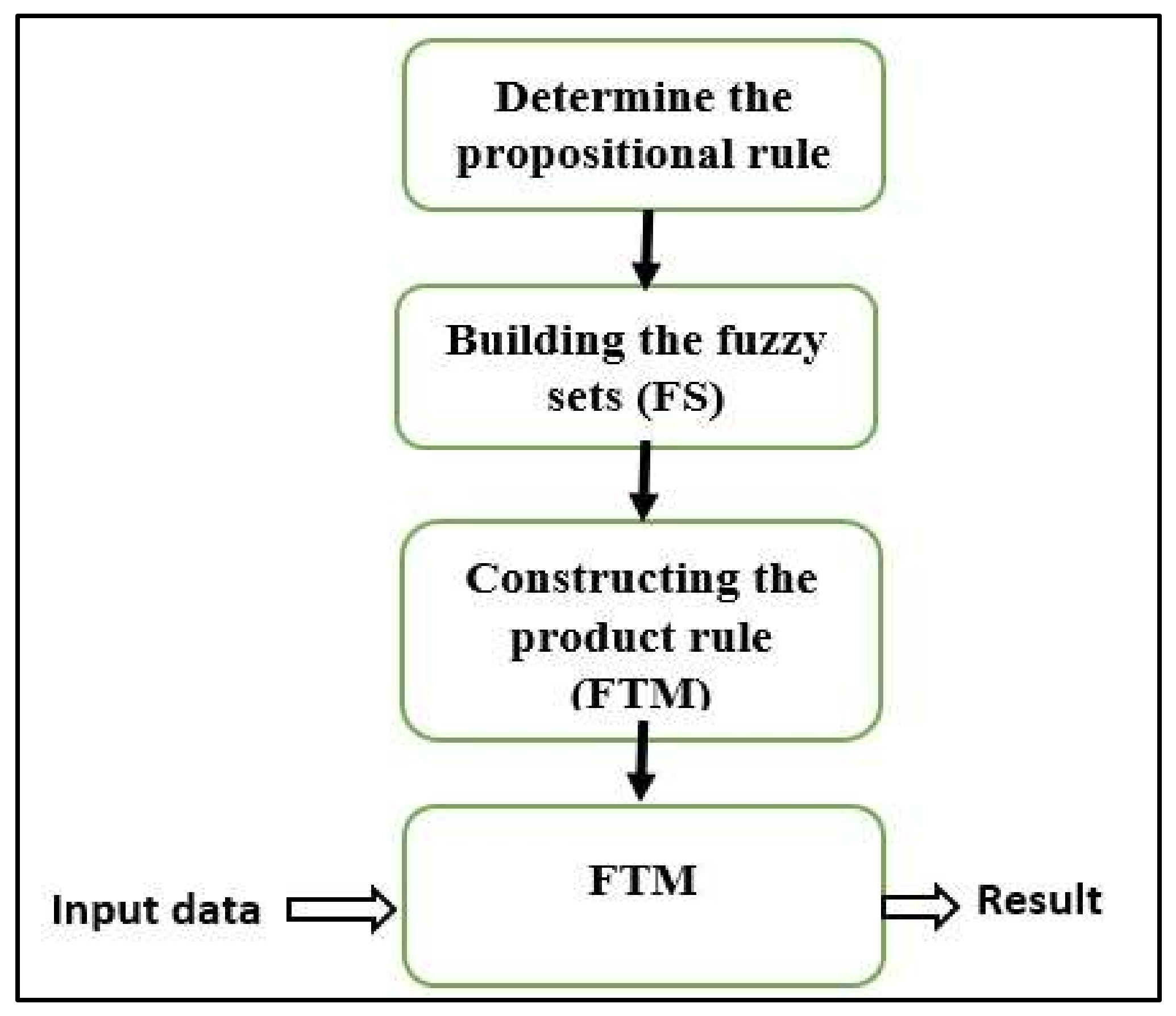
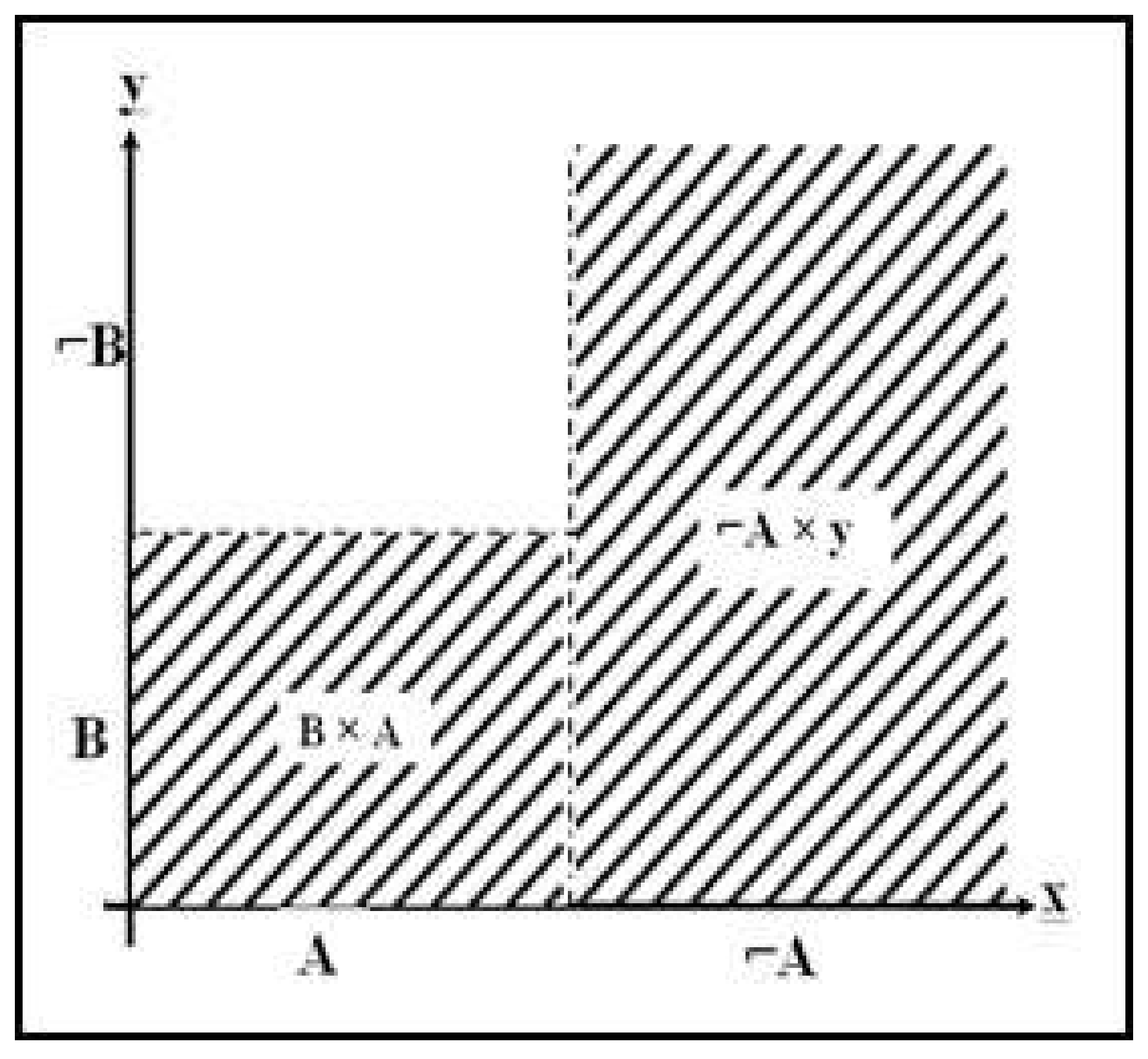
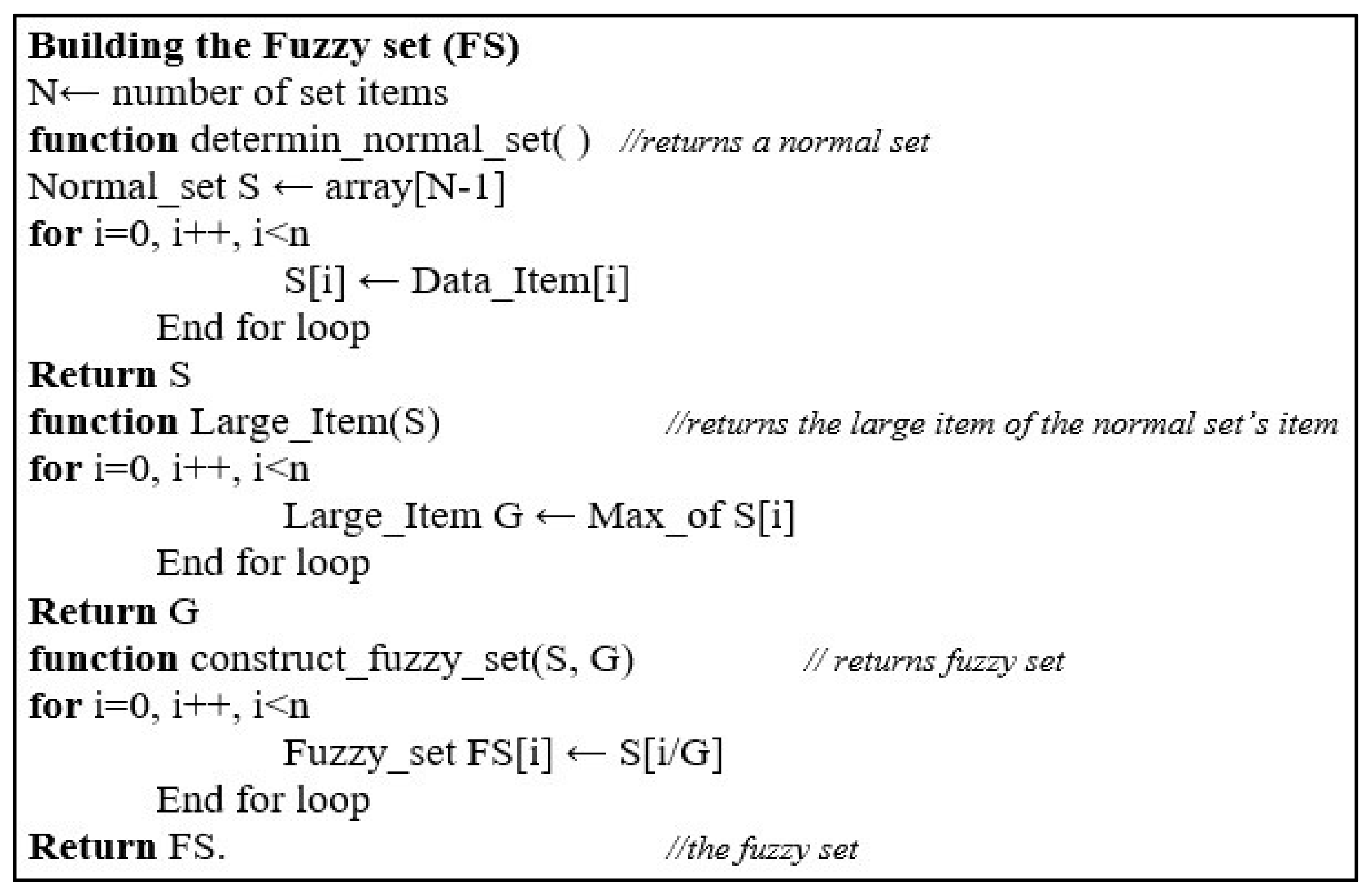
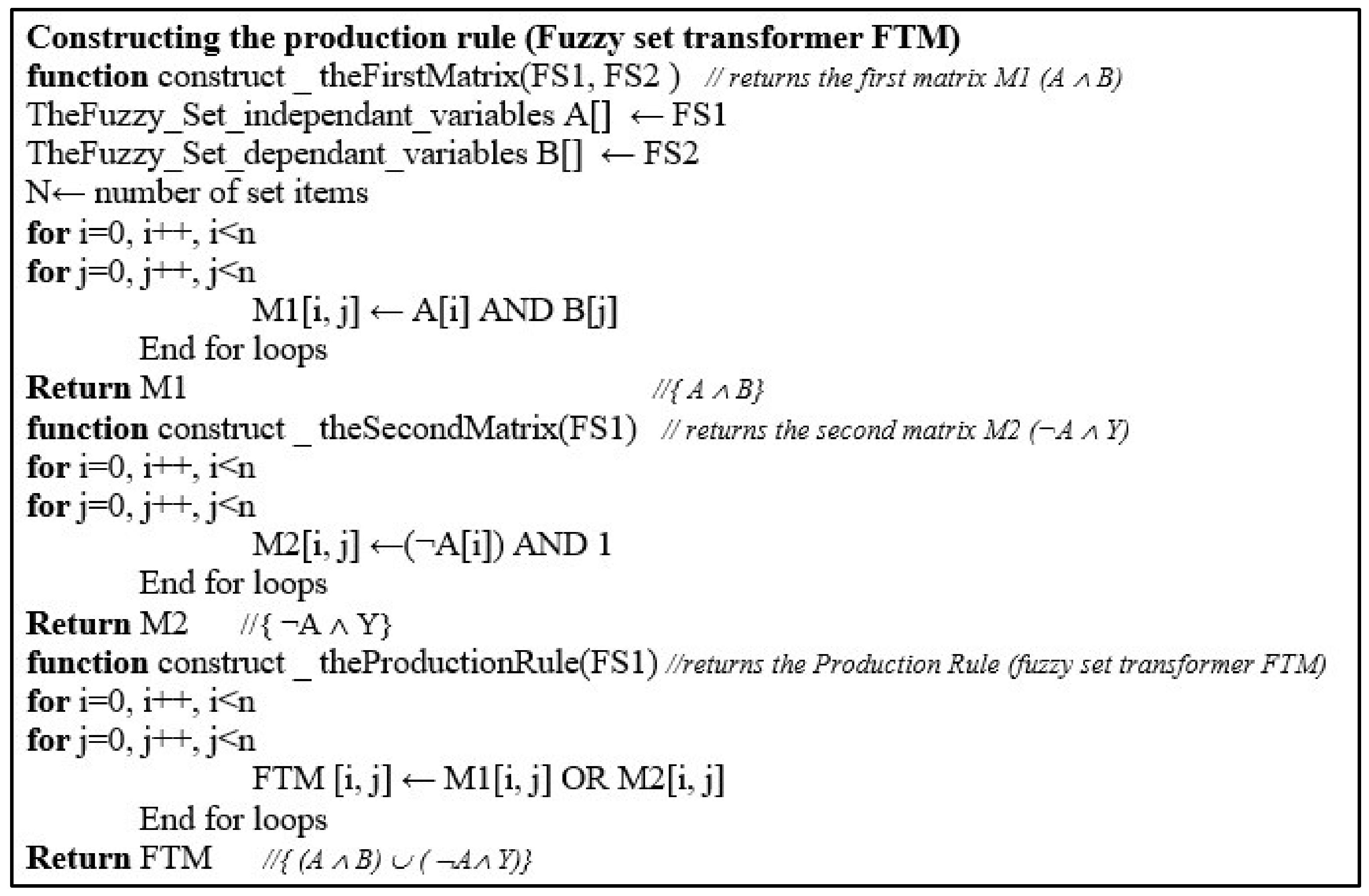
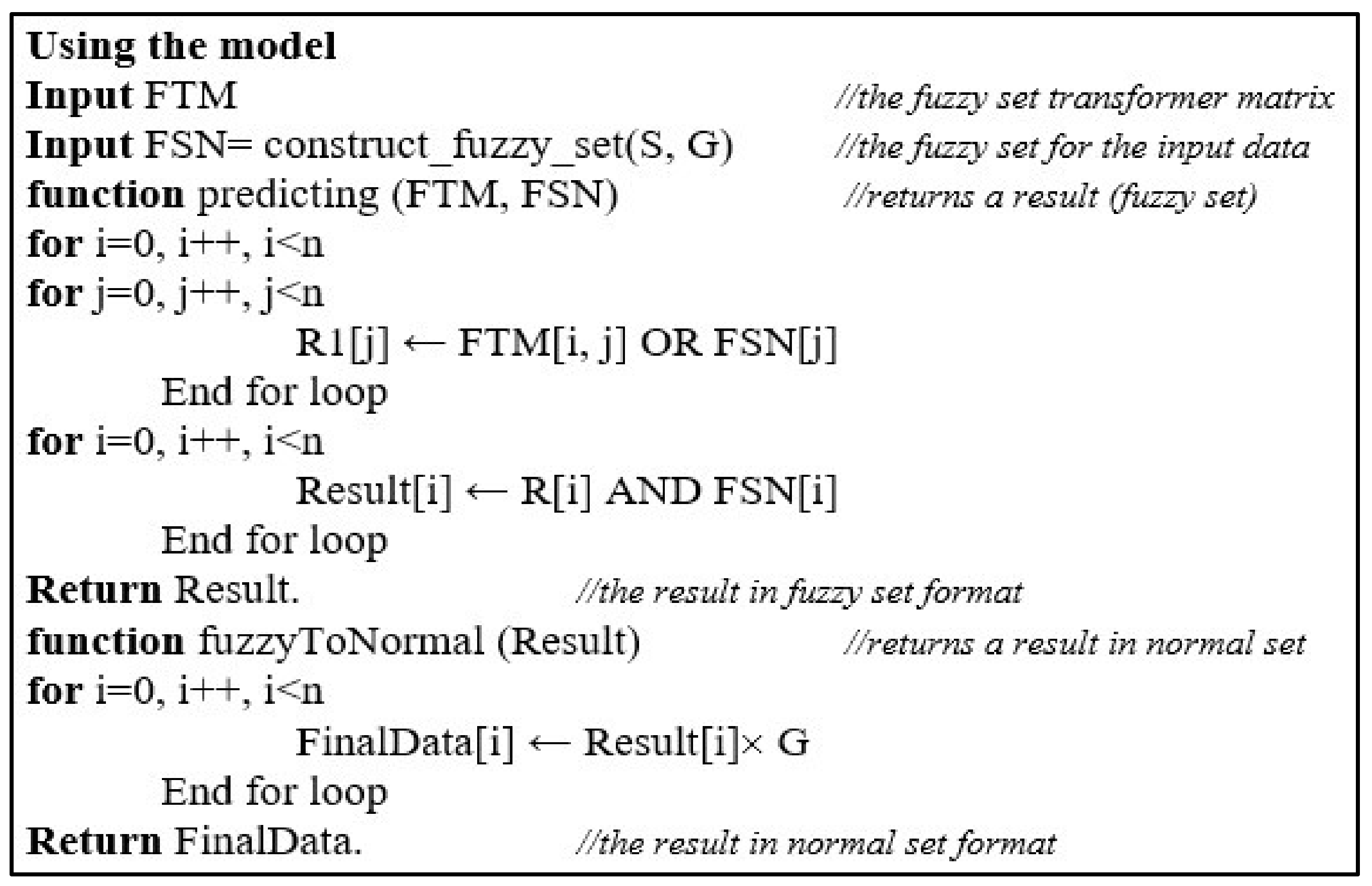

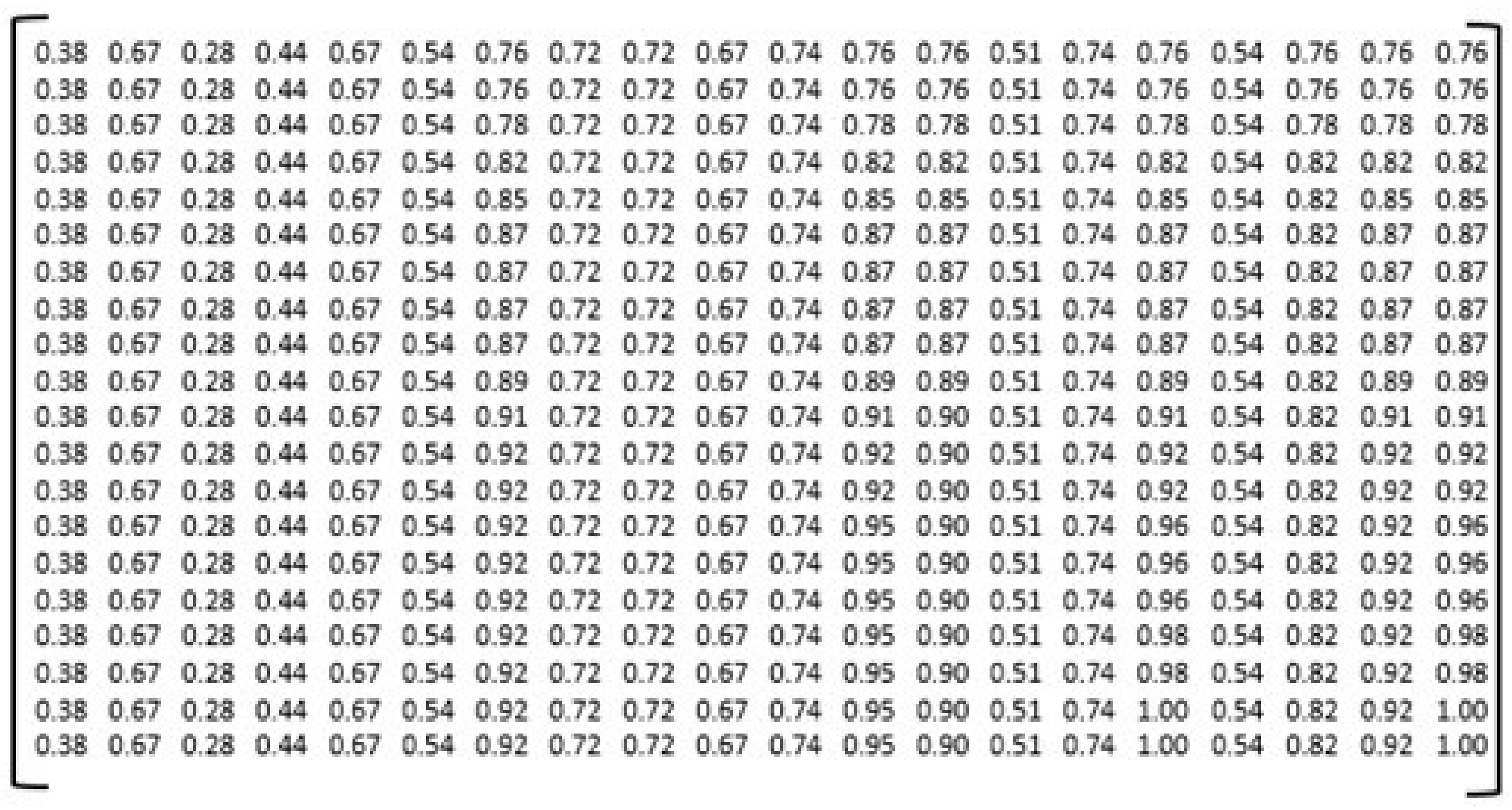
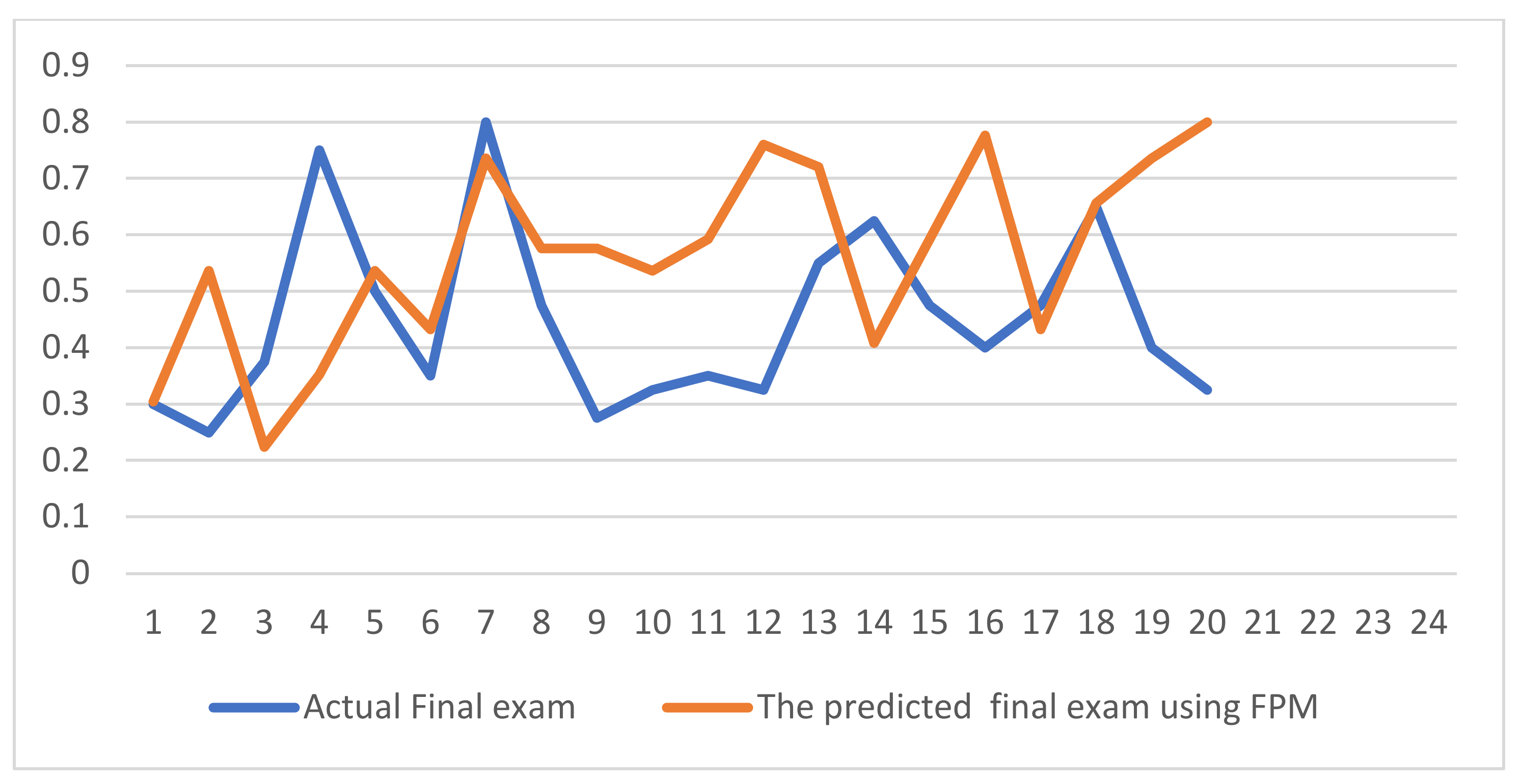
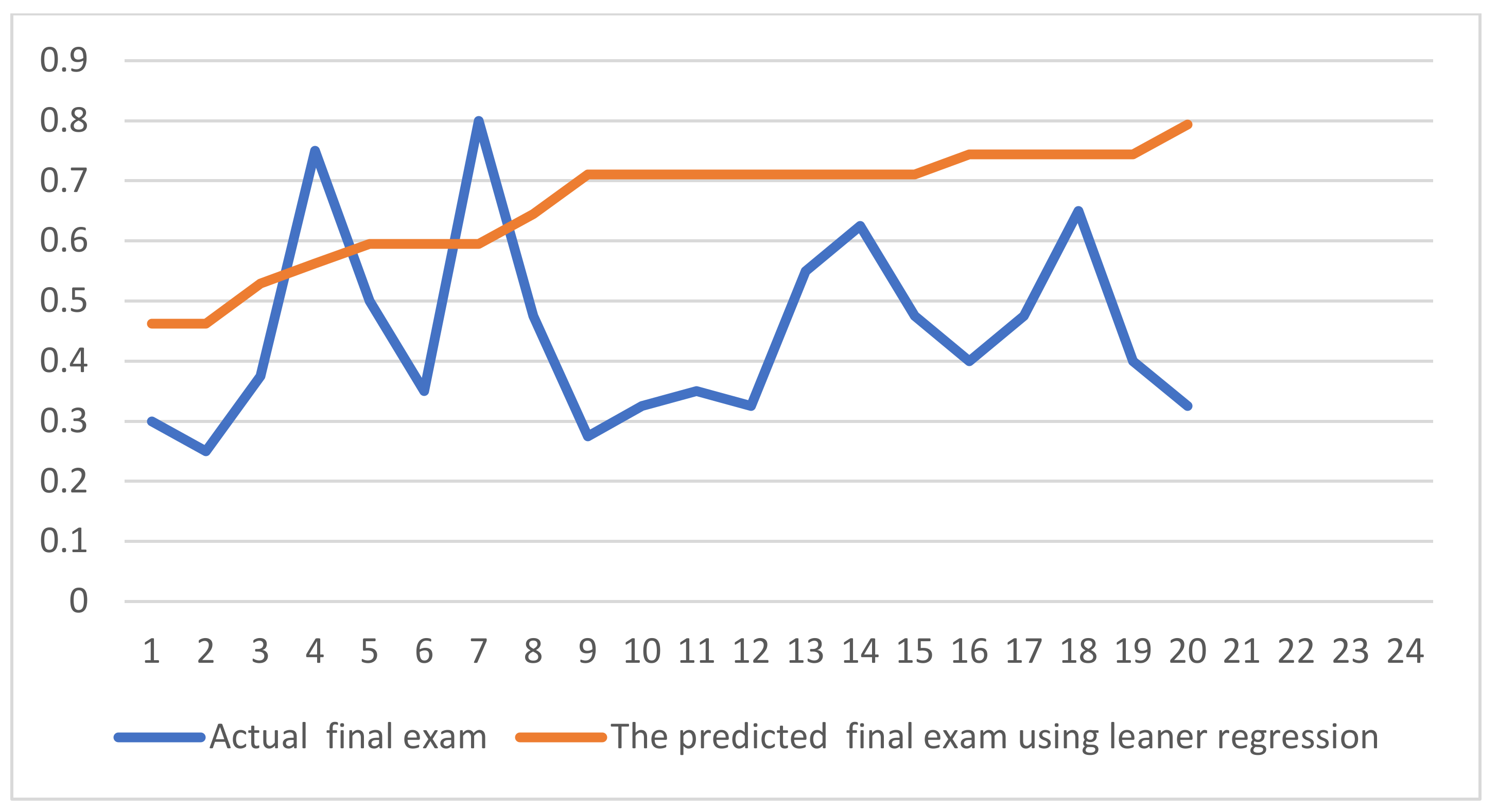
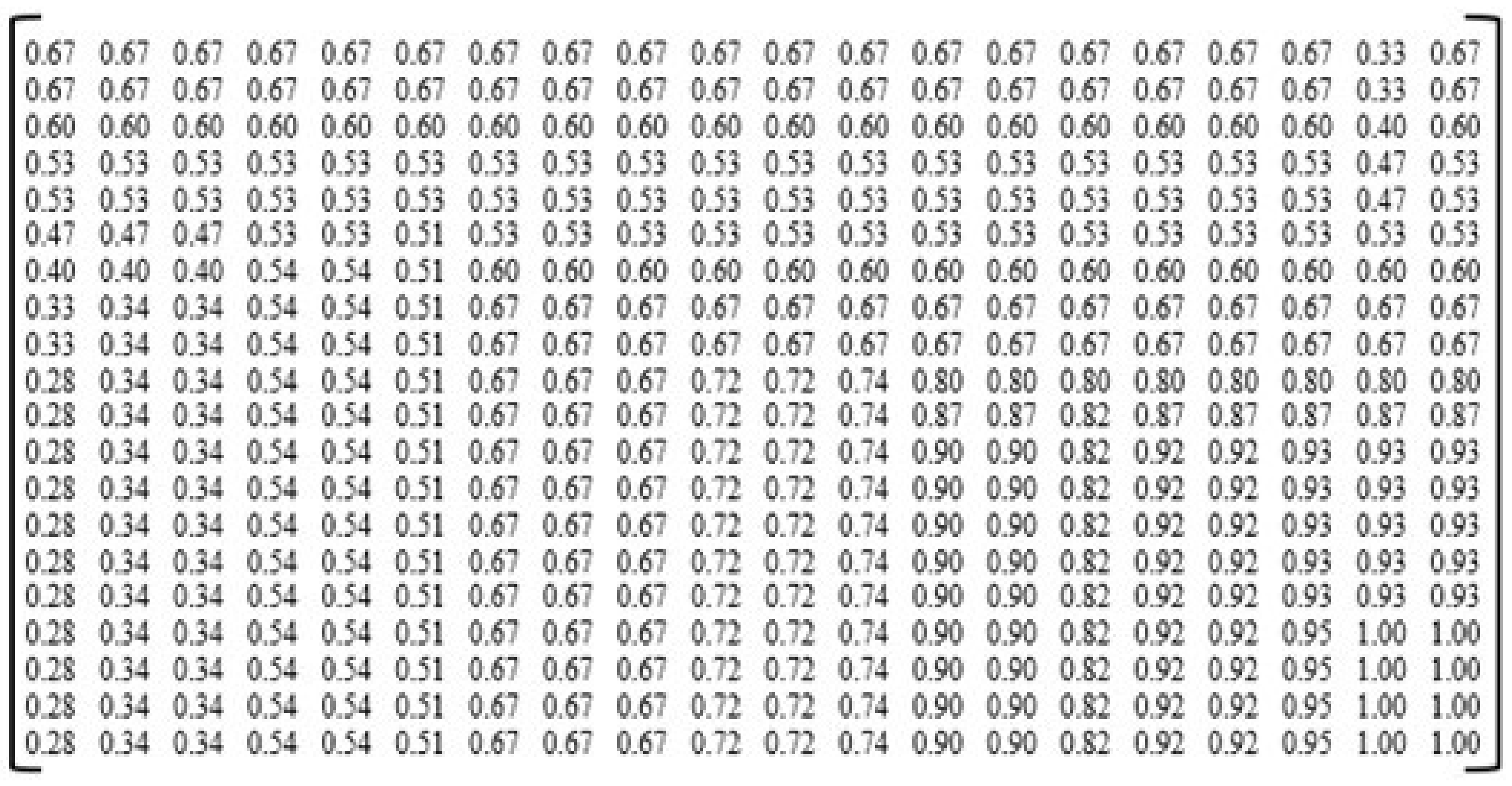
| No. | Section 1 (Training Set) | Section 1 (Test Set) | ||
|---|---|---|---|---|
| Attendance Rate | Final Exam Out of 40 | Attendance Rate | Final Exam Out of 40 | |
| 1 | 0.76 | 15 | 0.76 | 12 |
| 2 | 0.76 | 26 | 0.76 | 10 |
| 3 | 0.78 | 11 | 0.80 | 15 |
| 4 | 0.82 | 17 | 0.82 | 30 |
| 5 | 0.85 | 26 | 0.84 | 20 |
| 6 | 0.87 | 21 | 0.84 | 14 |
| 7 | 0.87 | 36 | 0.84 | 32 |
| 8 | 0.87 | 28 | 0.87 | 19 |
| 9 | 0.87 | 28 | 0.91 | 11 |
| 10 | 0.89 | 26 | 0.91 | 13 |
| 11 | 0.91 | 29 | 0.91 | 14 |
| 12 | 0.92 | 37 | 0.91 | 13 |
| 13 | 0.92 | 35 | 0.91 | 22 |
| 14 | 0.96 | 20 | 0.91 | 25 |
| 15 | 0.96 | 29 | 0.91 | 19 |
| 16 | 0.96 | 39 | 0.93 | 16 |
| 17 | 0.98 | 21 | 0.93 | 19 |
| 18 | 0.98 | 32 | 0.93 | 26 |
| 19 | 1 | 36 | 0.93 | 16 |
| 20 | 1 | 39 | 0.96 | 13 |
| No. | Tested Data Set Actual Data (Real Data for Testing the FPM) | Expected Data Developed by the Proposed FPM | Evaluation Results (Mean Squared Error) | ||||
|---|---|---|---|---|---|---|---|
| Attendance Rate | Final Exam 100% | Final Exam Fuzzy Set (Membership Degree)/32 | The Produced Fuzzy Set (Using Fuzzy Transformer) | Expected Final Exam 100% | Error Rate between Fuzzy Sets | Error Rate between Final Exam Mark and Expected Final Exam Mark Using this FPM | |
| 1 | 0.79 | 0.3 | 0.38 | 0.38 | 0.304 | 0.000 | 0.000 |
| 2 | 0.79 | 0.25 | 0.31 | 0.67 | 0.536 | 0.130 | 0.082 |
| 3 | 0.83 | 0.375 | 0.47 | 0.28 | 0.224 | 0.036 | 0.023 |
| 4 | 0.85 | 0.75 | 0.94 | 0.44 | 0.352 | 0.250 | 0.158 |
| 5 | 0.88 | 0.5 | 0.63 | 0.67 | 0.536 | 0.002 | 0.001 |
| 6 | 0.88 | 0.35 | 0.44 | 0.54 | 0.432 | 0.010 | 0.007 |
| 7 | 0.88 | 0.8 | 1 | 0.92 | 0.736 | 0.006 | 0.004 |
| 8 | 0.91 | 0.475 | 0.59 | 0.72 | 0.576 | 0.017 | 0.010 |
| 9 | 0.95 | 0.275 | 0.34 | 0.72 | 0.576 | 0.144 | 0.091 |
| 10 | 0.95 | 0.325 | 0.41 | 0.67 | 0.536 | 0.068 | 0.045 |
| 11 | 0.95 | 0.35 | 0.44 | 0.74 | 0.592 | 0.090 | 0.059 |
| 12 | 0.95 | 0.325 | 0.41 | 0.95 | 0.76 | 0.292 | 0.189 |
| 13 | 0.95 | 0.55 | 0.69 | 0.9 | 0.72 | 0.044 | 0.029 |
| 14 | 0.95 | 0.625 | 0.78 | 0.51 | 0.408 | 0.073 | 0.047 |
| 15 | 0.95 | 0.475 | 0.59 | 0.74 | 0.592 | 0.023 | 0.014 |
| 16 | 0.97 | 0.4 | 0.5 | 0.97 | 0.776 | 0.221 | 0.141 |
| 17 | 0.97 | 0.475 | 0.59 | 0.54 | 0.432 | 0.002 | 0.002 |
| 18 | 0.97 | 0.65 | 0.81 | 0.82 | 0.656 | 0.000 | 0.000 |
| 19 | 0.97 | 0.4 | 0.5 | 0.92 | 0.736 | 0.176 | 0.113 |
| 20 | 1 | 0.325 | 0.41 | 1 | 0.8 | 0.348 | 0.226 |
| Mean squared error | 0.096585 | 0.061985 | |||||
| No. | Attendance Rate | Final Exam 100% | Attendances − Mean (x − ) | Final − Mean (y − ) | (x − ) (y − ) | (x − )2 |
|---|---|---|---|---|---|---|
| 1 | 0.76 | 0.375 | −0.1365 | −0.31375 | 0.042827 | 0.018632 |
| 2 | 0.76 | 0.65 | −0.1365 | −0.03875 | 0.005289 | 0.018632 |
| 3 | 0.78 | 0.275 | −0.1165 | −0.41375 | 0.048202 | 0.013572 |
| 4 | 0.82 | 0.425 | −0.0765 | −0.26375 | 0.020177 | 0.005852 |
| 5 | 0.85 | 0.65 | −0.0465 | −0.03875 | 0.001802 | 0.002162 |
| 6 | 0.87 | 0.525 | −0.0265 | −0.16375 | 0.004339 | 0.000702 |
| 7 | 0.87 | 0.9 | −0.0265 | 0.21125 | −0.0056 | 0.000702 |
| 8 | 0.87 | 0.7 | −0.0265 | 0.01125 | −0.0003 | 0.000702 |
| 9 | 0.87 | 0.7 | −0.0265 | 0.01125 | −0.0003 | 0.000702 |
| 10 | 0.89 | 0.65 | −0.0065 | −0.03875 | 0.000252 | 0.000042 |
| 11 | 0.91 | 0.725 | 0.0135 | 0.03625 | 0.000489 | 0.000182 |
| 12 | 0.92 | 0.925 | 0.0235 | 0.23625 | 0.005552 | 0.000552 |
| 13 | 0.92 | 0.875 | 0.0235 | 0.18625 | 0.004377 | 0.000552 |
| 14 | 0.96 | 0.5 | 0.0635 | −0.18875 | −0.01199 | 0.004032 |
| 15 | 0.96 | 0.725 | 0.0635 | 0.03625 | 0.002302 | 0.004032 |
| 16 | 0.96 | 0.975 | 0.0635 | 0.28625 | 0.018177 | 0.004032 |
| 17 | 0.98 | 0.525 | 0.0835 | −0.16375 | −0.01367 | 0.006972 |
| 18 | 0.98 | 0.8 | 0.0835 | 0.11125 | 0.009289 | 0.006972 |
| 19 | 1 | 0.9 | 0.1035 | 0.21125 | 0.021864 | 0.010712 |
| 20 | 1 | 0.975 | 0.1035 | 0.28625 | 0.029627 | 0.010712 |
| Total | 0.182713 | 0.110455 | ||||
| b1 = 1.65418 b0 = −0.79422 | ||||||
| Attendance Rate | Expected Final Exam 100 % | Actual Final Exam in the Tested Data 100% | Mean Squared Error between Final Exam Mark and Expected Final Exam Mark Using This Model |
|---|---|---|---|
| 0.76 | 0.462954 | 0.3 | 0.026554 |
| 0.76 | 0.462954 | 0.25 | 0.04535 |
| 0.8 | 0.529122 | 0.375 | 0.023753 |
| 0.82 | 0.562205 | 0.75 | 0.035267 |
| 0.84 | 0.595289 | 0.5 | 0.00908 |
| 0.84 | 0.595289 | 0.35 | 0.060167 |
| 0.84 | 0.595289 | 0.8 | 0.041907 |
| 0.87 | 0.644914 | 0.475 | 0.028871 |
| 0.91 | 0.711081 | 0.275 | 0.190167 |
| 0.91 | 0.711081 | 0.325 | 0.149059 |
| 0.91 | 0.711081 | 0.35 | 0.13038 |
| 0.91 | 0.711081 | 0.325 | 0.149059 |
| 0.91 | 0.711081 | 0.55 | 0.025947 |
| 0.91 | 0.711081 | 0.625 | 0.00741 |
| 0.91 | 0.711081 | 0.475 | 0.055734 |
| 0.93 | 0.744165 | 0.4 | 0.11845 |
| 0.93 | 0.744165 | 0.475 | 0.07245 |
| 0.93 | 0.744165 | 0.65 | 0.008867 |
| 0.93 | 0.744165 | 0.4 | 0.11845 |
| 0.96 | 0.79379 | 0.325 | 0.219764 |
| Mean squared error (MSR) | 0.075834 | ||
| No. | Section 1 (Training Set) | Section 1 (Test Set) | ||
|---|---|---|---|---|
| Lab Exam Out of 15 | Final Exam Out of 40 | Lab Exam Out of 15 | Final EXAM out of 40 | |
| 1 | 5 | 15 | 5 | 12 |
| 2 | 10 | 26 | 4 | 10 |
| 3 | 5 | 11 | 5 | 15 |
| 4 | 6 | 17 | 13 | 30 |
| 5 | 9 | 26 | 9 | 20 |
| 6 | 7 | 21 | 5 | 14 |
| 7 | 15 | 36 | 15 | 32 |
| 8 | 13 | 28 | 8 | 19 |
| 9 | 12 | 28 | 5 | 11 |
| 10 | 10 | 26 | 5 | 13 |
| 11 | 14 | 29 | 5 | 14 |
| 12 | 15 | 37 | 5 | 13 |
| 13 | 14 | 35 | 10 | 22 |
| 14 | 8 | 20 | 12 | 25 |
| 15 | 14 | 29 | 7 | 19 |
| 16 | 15 | 39 | 6 | 16 |
| 17 | 7 | 21 | 7 | 19 |
| 18 | 14 | 32 | 12 | 26 |
| 19 | 14 | 36 | 6 | 16 |
| 20 | 15 | 39 | 4 | 13 |
| No. | Test Data Set Actual Data (Section 2 Data) | Predicted Data Developed by the Proposed FPM | Evaluation Results (Mean Squared Error) | ||||
|---|---|---|---|---|---|---|---|
| Lab Exam Out of 15 | The Final Exam Out of 40 | Final Exam Fuzzy Set/32 | The Predicted Fuzzy Set | The Predicted Final Exam | Error Rate between Fuzzy Sets | Error Rate between Final Exam | |
| 1 | 4 | 10 | 0.31 | 0.27 | 8.64 | 0.0018 | 1.8496 |
| 2 | 4 | 13 | 0.41 | 0.27 | 8.64 | 0.0186 | 19.0096 |
| 3 | 5 | 12 | 0.38 | 0.33 | 10.56 | 0.0020 | 2.0736 |
| 4 | 5 | 15 | 0.47 | 0.33 | 10.56 | 0.0193 | 19.7136 |
| 5 | 5 | 14 | 0.44 | 0.33 | 10.56 | 0.0116 | 11.8336 |
| 6 | 5 | 11 | 0.34 | 0.33 | 10.56 | 0.0002 | 0.1936 |
| 7 | 5 | 13 | 0.41 | 0.33 | 10.56 | 0.0058 | 5.9536 |
| 8 | 5 | 14 | 0.44 | 0.33 | 10.56 | 0.0116 | 11.8336 |
| 9 | 5 | 13 | 0.41 | 0.33 | 10.56 | 0.0058 | 5.9536 |
| 10 | 6 | 16 | 0.50 | 0.4 | 12.8 | 0.0100 | 10.2400 |
| 11 | 6 | 16 | 0.50 | 0.4 | 12.8 | 0.0100 | 10.2400 |
| 12 | 7 | 19 | 0.59 | 0.47 | 15.04 | 0.0153 | 15.6816 |
| 13 | 7 | 19 | 0.59 | 0.47 | 15.04 | 0.0153 | 15.6816 |
| 14 | 8 | 19 | 0.59 | 0.53 | 16.96 | 0.0041 | 4.1616 |
| 15 | 9 | 20 | 0.63 | 0.6 | 19.2 | 0.0006 | 0.6400 |
| 16 | 10 | 22 | 0.69 | 0.67 | 21.44 | 0.0003 | 0.3136 |
| 17 | 12 | 25 | 0.78 | 0.8 | 25.6 | 0.0004 | 0.3600 |
| 18 | 12 | 26 | 0.81 | 0.8 | 25.6 | 0.0002 | 0.1600 |
| 19 | 13 | 30 | 0.94 | 0.87 | 27.84 | 0.0046 | 4.6656 |
| 20 | 15 | 32 | 1.00 | 1 | 32 | 0.0000 | 0.0000 |
| Mean squared error (MSR) | 0.006863 | 7.02792 | |||||
| Models | MBE | NSE | RMSE |
|---|---|---|---|
| Our proposed model (FPM)—absenteeism data (First scenario) | 0.115 | −1.648 | 0.249 |
| Linear regression—absenteeism data (First scenario) | 0.211 | −2.24 | 0.275 |
| Our proposed model (FPM)—lab exam data (Second scenario) | −2.174 | 0.812 | 2.651 |
| Linear regression—lab exam data (Second scenario) | −1.807 | 0.883 | 2.331 |
| The fuzzy logic system of [30] | 7.4833 | ||
| The neuro fuzzy model of [31] | 9.287 |
Disclaimer/Publisher’s Note: The statements, opinions and data contained in all publications are solely those of the individual author(s) and contributor(s) and not of MDPI and/or the editor(s). MDPI and/or the editor(s) disclaim responsibility for any injury to people or property resulting from any ideas, methods, instructions or products referred to in the content. |
© 2023 by the authors. Licensee MDPI, Basel, Switzerland. This article is an open access article distributed under the terms and conditions of the Creative Commons Attribution (CC BY) license (https://creativecommons.org/licenses/by/4.0/).
Share and Cite
Hegazi, M.O.; Almaslukh, B.; Siddig, K. A Fuzzy Model for Reasoning and Predicting Student’s Academic Performance. Appl. Sci. 2023, 13, 5140. https://doi.org/10.3390/app13085140
Hegazi MO, Almaslukh B, Siddig K. A Fuzzy Model for Reasoning and Predicting Student’s Academic Performance. Applied Sciences. 2023; 13(8):5140. https://doi.org/10.3390/app13085140
Chicago/Turabian StyleHegazi, Mohamed O., Bandar Almaslukh, and Khadra Siddig. 2023. "A Fuzzy Model for Reasoning and Predicting Student’s Academic Performance" Applied Sciences 13, no. 8: 5140. https://doi.org/10.3390/app13085140
APA StyleHegazi, M. O., Almaslukh, B., & Siddig, K. (2023). A Fuzzy Model for Reasoning and Predicting Student’s Academic Performance. Applied Sciences, 13(8), 5140. https://doi.org/10.3390/app13085140







